The last fortress of the Russian Empire
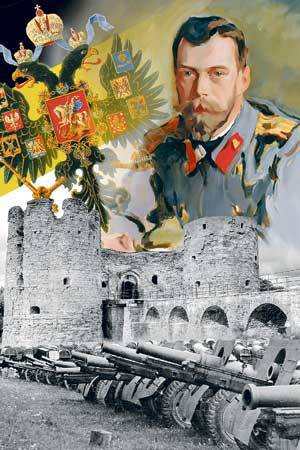 She could not resist the onslaught of the enemy, because she did not meet modern requirements.
She could not resist the onslaught of the enemy, because she did not meet modern requirements.One of the reasons for the defeat of Russia in the First World War was the disastrously fast surrender of all Russian fortresses in 1915. Whereas in France, the fortress (Verdun and others) stopped the German offensive in 1914.
DECAY - DO NOT DESTINY
Construction of modern fortresses on the western borders of the Russian Empire began at the behest of Nicholas I as early as 1831. Six decades later, by December 20 1893, on these lines, there were fortresses of the first and second lines (Novogeorgievsk, Brest-Litovsk, Ivangorod, Warsaw, Kovno, Osovets, Zegrzh). They were armed with 5068 artillery pieces, mostly heavy (1867 and 1877 sample guns: 203-mm - 203, 152-mm - 1642, 122-mm - 477, 107-mm - 1027, 1867 and 1877 mortars, 203, 145, 152-mm - 371, XNUMX mortars and XNUMX mortars -mm - XNUMX, XNUMX-mm - XNUMX).
I note that during the times of Alexander II and Alexander III, the quality of Russian guns was in no way inferior to the German counterparts. Fortunately, they were designed by the same engineers - from the company Krupp.
Based on the data of officers of the Prussian General Staff, Friedrich Engels wrote: “The Russians, especially after 1831, did what their predecessors missed. Modlin (Novogeorgievsk), Warsaw, Ivangorod, Brest-Litovsk form a whole system of fortresses, which, by a combination of its strategic capabilities, is the only one in the world. ”
However, in the reign of Nicholas II in Russia there was not a single heavy modern weapon (that is, with a rollback along the canal axis), unless, of course, the 6-dm (152-mm) howitzer of the 1909 sample of the year is considered. But she was more corps than a serf weapon. As a result, by the end of the first decade of the twentieth century, the Russian serf artillery fleet was fairly outdated: about 30% of its composition fell on the 1877 model guns of the year, 45% - 1867, 25% - smooth-bore systems from the time of Nicholas I. And not a single cannon, howitzer or mortars among 11 thousands of guns!
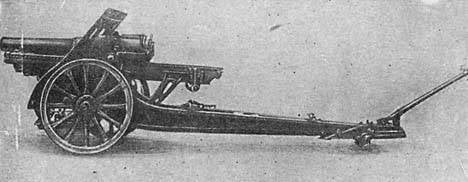
Due to the lack of new products in 1911, siege (that is, heavy land) artillery was disbanded in Russia. Her guns were scrapped or stored in fortresses. And she would appear again in the Russian army according to the plans of the Grand Duke Sergei Mikhailovich, an artillery inspector-general only by 1922. The fortress artillery would have received new weapons by the year of 1930.
Meanwhile, the plans for the construction of the western fortresses of Russia were radically revised almost every year. In February, 1909 of the year, according to the report of the Chief of the Main Directorate of the General Staff V. A. Sukhomlinov, Nikolai II ordered the abolition of the New George Fortress, considered to be first-class, and also Batumi, Ochakov and Ust-Dvinsk. At the same time, the tsar approved the speedy restoration of the fortifications of Brest-Litovsk, Kronstadt, Vyborg, Vladivostok to “proper form”, since, Sukhomlinov claimed, “preserving the fortresses in the state” they were in then would be “treason”.
True, a year and three months later, in May 1910, the new head of the Main Headquarters, General E. A. Gerngross, asked Nikolai for another order, according to which the fortresses Novogeorgievsk, Batum, Ust-Dvinsk and Ochakov were not only abolished, but had to be rearranged, to meet modern requirements. Surprise this is not necessary. At various times, the king, without further ado, agreed with conflicting opinions. Here, for example, 1 January 1910, he allowed to abolish the Ivangorod fortress. And on November 26, 1913 th waved "The highest approval for the preservation and partial reorganization of the Ivangorod fortress."
In the course of this confusion, it was decided to create another powerful stronghold in the west - in Grodno. It is rightly called the last fortress of the Russian Empire.
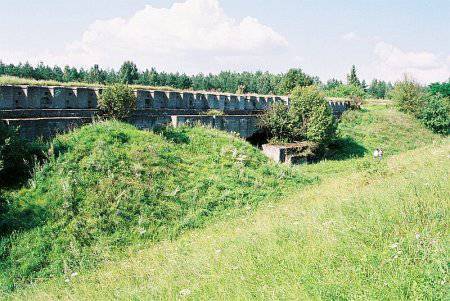
CYTADEL SAMPLE XIX CENTURY
Back in 1831, during the Polish insurrection in St. Petersburg, they set out to enclose Grodno with earthworks. However, while bureaucratic red tape was going on, the violent pans were pacified, and therefore everything that had been planned remained on paper. It is curious that the authorities at that time introduced a special tax for local residents in order to raise additional funds for construction. Money was regularly collected for several years. Where did they go then - the secret of the Engineering Department.
4 August 1912, Nicholas II approved the next plan for the construction of the Grodno fortress. It was to consist of 16 forts, corresponding to standard designs developed by military engineers K. I. Velichko, N. A. Buynitsky and V. V. Malkov-Panin, 18 lettered strongholds, 38 numbered strong points for infantry regiment.
After discussion, the plan was amended, and it was reviewed on 2 June 1912 of the Year by the Engineering Committee of the Main Engineering Department. In the new version, the number of forts has decreased to 13, number of strong points - to 23, and the number of forts - increased to 19. In addition to them, it was supposed to build open batteries for large-caliber guns, separate shelters for infantry, powder magazine, airfield, dam, road and a number of auxiliary structures. The border of the fortress area was approximately 10 km from the projected line of forts.
Immediately it should be noted that the project of the fortress is outdated by the years on 40-50. The city center was at a distance of 6-8 km from the line of the forts and could even be fired upon by enemy corps artillery. And already from the end of the 19th century 80, Russian officers — general staff officers and engineers — suggested connecting the western fortresses with a solid line of fortifications, that is, creating fortifications. But the military ministers, Generals A. N. Kuropatkin and V. A. Sukhomlinov, were going to wage war according to the rules of the mid-19th century.
2 July 1912 was appointed the newly-built Major General D. P. Kolosovsky as the builder of the Grodno fortress. September 1 1912 year he was issued an order of the Main Engineering Committee, which said: “Now present a plan for the distribution of credits for the 4 anniversary of 1912-1915, guided by consideration of the cost of engineering works and blanks, bearing in mind that due to the estimated creation work Grodno Fortress amount in the amount of 15 950 000 rub. already allocated in 1912 204 000 rub. and is intended to be allocated in 1913 g. - 3 746 000 rub., in 1914 g. - 5 000 000 rub. and 1915 g. - 7 000 000 rub. "
I note that the allocated money was clearly not enough, since the price of erecting only one fort number 4 near the village of Strelchiki reached 2 300 000 rubles at prices 1913 of the year.
The work around Grodno should be finally completed in 1917. However, on August 23 of 1913, the city was declared a fortress by the imperial command, although the construction of the main fortress position was at the initial stage. The fortress also did not have a real garrison and armament. Nevertheless, Lieutenant-General M. N. Kaygorodova appointed her commandant.
The work was distributed among 14 construction sites, with engineering officers at their head. In addition to soldiers, civilian workers and local peasants hired by civilian contractors worked here.
During the construction of the forts of Grodno, they took the 1909 project of the year, developed by General K. I. Velichko, as a basis. Its peculiarity consisted in the fact that from the very beginning of the works, the fortification was adapted to defense. At the first stage of construction - as a field redoubt, then - as a temporary stronghold with a concrete parapet and a moat with the rudiments of countermine galleries and worn, which could be used as safe havens during bombing. At the very last, intermediate and hull semi-celebrities, hull barracks were built, scarp and counter escarp were faced.
And yet, by the beginning of the World War, not a single fort of the Grodno fortress was ready and half. In each of the fortifications there were only rifle boxes and sub-galleries. They did not have time to build kofirs (on some forts, work on their construction had just begun), neither polukaponiry, nor even wretched, countermines galleries and gorzhevye barracks. In addition to large forts, several so-called small forts were also built in the 1, 3, 4, 5 forts groups.
WAR!
13 July 1914, General of Infantry M. N. Kaygorodov signed Order No. 45, whose 1 paragraph read: “By imperial order, I declare the fortress of Grodno in a state of war”. At the same time, the entire Grodno region also went to martial law.
The next day, a telegram came from N. A. Maklakov, the Minister of Internal Affairs, ordering to enact the “Provision on the preparatory period for a war”. 16 July Nicholas II announced the mobilization, then he canceled it, and early in the morning on July 17 announced again. July 19 (that is, August 1 in a new style) Germany offered Russia to stop the call of the storekeepers and, having been refused, declared war on it.
Not only people but also cars and motorcycles were subject to mobilization. The drivers who drove these cars, after being examined by medical commissions and not being rejected by them, were considered to be accepted for military service from that moment on. (I note in parentheses that the relevant document stated: "Persons belonging to Judaism cannot be chauffeurs in the troops.")
Owners of cars that did not put them at the disposal of the army on time without a good reason could be put in prison for up to three months. However, the well-known ballerina Kshesinskaya did not give the military any of her three iron horses, but, of course, she did not please the prison ...
As for Grodno, 22 cars and 5 motorcycles were taken away from the local inhabitants. All of them were made available to the commandant of the fortress.
Meanwhile, the construction of the Grodno fortress did not stop. In the study of V.N. Tiles “Fortress City. Grodno during the First World War "this situation is described:" If at the end of July - beginning of August 1914, 2746 people and 301 supplies worked at defensive objects from Grodno and the county, in March, 1915, they were already 7596 people and 1896 supplies. And by 15 in March 1915, 28 515 people and the 8350 approach were engaged in all the serf and positional work in the fortified area. ”
31 December 1914 of the year, says V.N. Tile in his book, from the Grodno and other western provinces of Russia began the mass expulsion of "all German male colonists aged 15 years and older, except for patients unable to withstand the move. When evicting, follow the instructions below: 1) under the colonists, all peasants of Russian nationals of German nationality should be understood; 2) Germanized Lutheran Lithuanians are also subject to eviction. ”
In the autumn of 1914, Nicholas II deigned to inspect the fortresses in the front line. October 30 king came to Ivangorod. First of all, he went with the commandant Schwarz to the cathedral, then to the battery number 4, after which he visited the church in Opatstvo. “I drove to Fort Vannovsky ... I returned to the train with darkness,” the emperor writes in his diary. Let me remind you that the sunset 30 October (old style) in 16.30. Thus, on the cathedral, church, battery and fort, His Majesty took about three hours.
But back to the royal diary: “November 1. Saturday. In 10 hour. morning rolled to Grodno. He took commanders and deputies from the provinces. In 10 1 / 2 Alix arrived with Olga and Tatiana. It was a joy to meet. We went together to the cathedral, and then to two hospitals with the wounded. The weather was cold and rainy. Had breakfast on the train. In 2, 1 / 4 traveled with the commandant Kaigorodov through the city along the Osovetskoe highway. I drove to the fort number 4 on the hill. I listened to the report on the work to strengthen the defense of the fortress. Inspected the fort and then the battery number 19. Returned to the train about 5 hour. ".
So, on the way there and back and on the inspection of the battery and the fort took only three hours.
That such royal attention was paid to the western fortresses of Russia!
BASIC OLDER
By the beginning of World War I, the most powerful guns of the Grodno fortress were 24 six-inch guns of the 1904 model of the year. Although they were released after the Japanese campaign, they were designed as early as the beginning of the nineteenth-century 90 and differed from the prototypes made earlier by only slightly improved ballistics and a wedge gate that replaced the piston.
In addition, the fortress artillery included 95 six-inch (ammunition - 8550 shots) and 24 42-linear, that is, 107-mm, guns (3600 shots) model 1877 of the year. The 12 battery and 57 light guns were supposed to be used as anti-assault guns. Let me explain to the modern reader: this is about the 107-mm and 87-mm field guns of the 1877 model of the year. The fortress also had 53 new three-inch (76-mm) anti-storm guns of the 1910 model of the year on wheeled carriages.
The 23 six-inch Schneider howitzers of the model 1909 of the year and 8 of eight-inch mortars of the model of 1877 of the year were intended for mounted combat. But the latter, apparently, the fire could not.
The funny thing is that in the first months of the war the tsar and the Supreme Commander, Grand Duke Nikolai Nikolayevich decided to use the Russian serf artillery against enemy ... fortresses. 10 (23) of October 1914 of the Year The Stake issues an order to send weapons from Kovno to Koenigsberg, from Grodno to Thorn and GROUNDENTS, from Osovets to Letzen, from Novogeorgiyevsk to Poznan. But soon the situation on the fronts changed dramatically and the transfer was canceled ...
... The 1915 year came, and the armament of the Grodno fortress remained the same as in August 1914. Meanwhile, the German troops approached her closer and closer, and the Russian generals, forgetting about Koenigsberg and Thorn, began feverishly, from the pine forest, to collect artillery for Grodno. In particular, at the end of 1914 - March 1915 of the year, four six-inch guns and eight 42-linear guns of the model 1877 of the year were sent from Vyborg fortress to Belarus. Another 12 six-inch guns and four 42-linear guns were brought from Petrograd. In addition, in Grodno, fifty 57-mm Nordenfeld coastal cannons from coastal fortresses were used there to fire heavy guns.
At the end of the summer, 1915 from the 2 division of the heavy cannon artillery regiment in Grodno took two 10-inch (254-mm) coastal cannons on Durlacher and 493 TNT bombs to them, as well as four 152-mm Kan guns with 1200 TNT bombs and 113 shrapnel. These tools were installed in Grodno on temporary wooden grounds.
At the beginning of 1915, Russia purchased twenty-seven 28-cm howitzers and thirty-four 24-cm howitzers from Japan, although they were outdated by at least 20 years. Fourteen 28-cm and ten 24-cm howitzers in September 1915 were met in Grodno. Not only were these guns old, shells attached to them, stuffed with smokeless powder at the end of the 19th century. By explosive action, they were several times inferior to TNT shells of the same caliber.
In addition to the above, in accordance with the telegram of the Chief of Staff of the Supreme Commander from 16 on June 9, 1915, from the Sevastopol fortress to Grodno, in the second half of 1915, seven 11-inch guns of the 1877 model of the year were sent with 340 shots to the barrel, nine nineteen nineteen nineteen nineteen guns of the nineteen nineteen guns of the 24 model with 1877 shots per barrel with 200 shots on the barrel and 60 field guns of the 1877 sample of the year. But these guns did not get into the Grodno fortress. Three 11-inches were returned to Sevastopol, and the rest of the guns were sent to the formation of spare battalions of fortress artillery.
DOMESTIC DEATH
In August 1915, German troops broke through into Grodno. On August 16, two corps were transferred to the direct subordination of the commandant of the fortress MN Kaygorodov - Consolidated Osovetsky (57 and 111-I infantry divisions) and 1-th army (22 and 24-I infantry divisions). On the flanks of Grodno, they covered parts of four more corps under the command of generals Artemiev, Balanin, Evreinov and Korotkevich. On the same day, an order was issued to the Osovetsky and 1 Army Corps to leave their positions and take up defense on the serf line. On the area from the village of Trichy to the fort number 4, the 24 Infantry Division was stationed under the command of Major General Polyansky (4,5 thousands of bayonets) and attached to her 118, 119, 120, 239 I state militia. Their neighbors on the right and left were the 57 and 22-I infantry divisions.
On August 17, the Germans attacked parts of the 1 Army Corps and, after a stubborn battle, managed to advance. The next morning, deploying one division in the direction of the villages of Rogachi, Beliany, Kustintsy, the enemy immediately seized Russian positions.
August 21 (September 2) German troops on the pontoons forced the Neman. Fighting started on the streets of Grodno. By the middle of the day 22 August, the Germans occupied the city, capturing more than two thousand prisoners.
According to the report of the command of the Grodno fortress to 21.00 22 in August, most of its forts managed to blow up. But in reality they received only minor damage. This is easily seen even now by visiting the abandoned fortifications. Some forts generally remained safe and sound. For example, Captain Desnitsky reported in his report: “At Fort IV, they could not undermine anything, since the cords were removed from the demolition men by the lower ranks. The powder magazine was not blown up, because it was occupied by the Germans before we left the fort. ”
Yes, the last fortress of the Russian Empire ingloriously perished ...
Most of the serf artillery fell into the hands of the enemy intact. It is curious that in two 10-inch (254-mm) cannons on Durlächer's gun carriages German specialists inserted new 238-mm caliber pipes. Due to this, it was possible to improve the ballistic data of the guns, which were listed in the Kaiser army and the Wehrmacht as 24-cm SKL / 50 guns. They did not have time to participate in the First World War. But from July 1940 until August 1944, they happened to hold the English Channel at gunpoint while on the Oldenburg battery, located a few kilometers north of Calais.
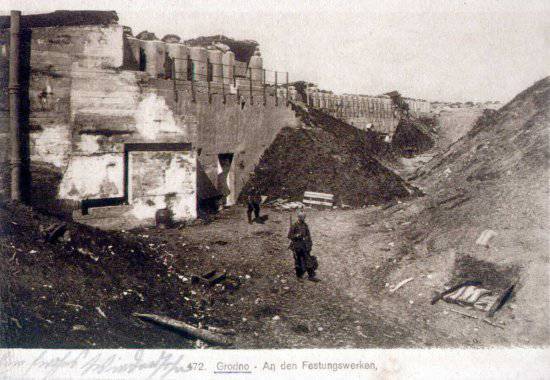
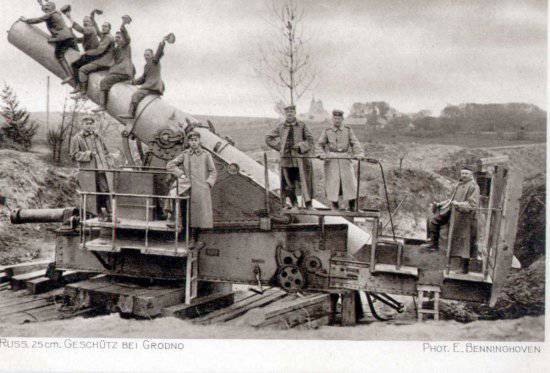
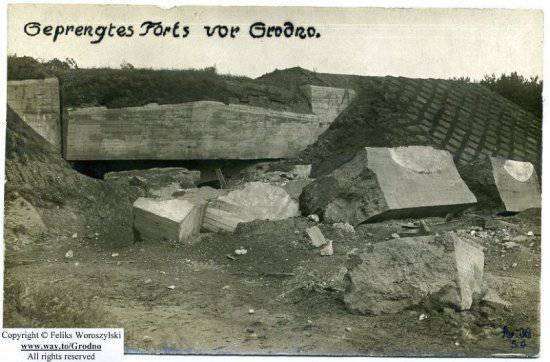
Information